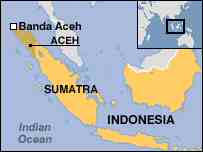Acehnese yearn for water after tsunami catastrophe
Source: The Jakarta Post

Fadli, The Jakarta Post/Banda Aceh
It has been over 40 days now that Hasri has been getting water from a little-used well behind his house after the tap water dried up in the wake of the huge earthquake and tsunami that hit Banda Aceh on Dec. 26.
"When the tsunami struck, the tap water stopped. We don't know when the tap water will come back on," said Hasri, who lives in Lamlagang district in Banda Aceh, which largely escaped the tsunami's swath of devastation as it is located on relatively high ground.
He said the tap water from Tirta Daroy water company was used for most water needs, including drinking and cooking. Water from the well, however, can only be safely used for bathing and doing the laundry, while for drinking purposes, he had to buy bottled water.
"With no tap water, we're in trouble. We spend a lot of money on mineral water to drink," said the 36-year-old as he drew water from the well in a traditional way, with a bucket and rope.
Another Acehnese man, Arif, waits in long lines every couple of days to get 12 liters of free water, which is donated and distributed by Australian military personnel in the Simpang Lima area.
The 25-year-old driver of a becak mesin (motorized pedicab) said the water was used for drinking.
"For bathing, we use water from a well, but the water I get from the Australian military is used for drinking. I usually stand in line about one hour," Arif said, adding that when he was too tired to wait in line, he would drink water from the well.
People's dependence on the water company is high as the local company has been the only one in the area since 1980.
After the massive earthquake rocked the region, water distribution from Tirta Daroy stopped, leaving only a few neighborhoods with access to clean water.
Head of the technical division of Tirta Daroy, Mukhlis, said the company suffered Rp 10 billion (US$1.1 million) in losses in the disaster. The greatest amount of damage occurred on many of water distribution pipes as well as the operational building in Lampineng.
The broken distribution pipes disrupted water service to the customers' houses, he explained.
Before the disaster struck, the company distributed clean water to 25,000 houses, with water capacity of 450 liters per second. Now, only 25 percent of those homes can get water, or about 8,000 customers.
"Two units of our clean water processing facility were not damaged in the disaster. But the clean water distribution is disrupted because of the broken pipes," Mukhlis said.
He said the undamaged pipes were located in Ulee Kareng, Lueng Bata, and parts of Lamtemen and Lamlagang, while almost all the distribution pipes in Banda Aceh were damaged to some degree.
"Our worst hit customers were those in the tsunami-struck areas, but there are also those that weren't affected by the tsunami, but they cannot get water because of the damaged pipes," Muklis said.
To provide clean water, there were two clean water units donated by U.S. company General Electric (GE) with a processing capacity of 40 liters per second in Lambaro, Aceh Besar. Another unit was provided by the Bandung Institute of Technology and Siliwangi Military Command, with a capacity of one liter per second.
"But the donated units are not connected to the distribution pipes. Water from those units are only distributed to displaced persons shelters and for other needy families," Mukhlis said.
He said he did not know when the company could start operating on a normal basis. Many of the company's employees were also killed or seriously injured in the disaster, with 28 of its 172 employees confirmed dead.
Before they could start repairing the distribution pipes, he said the company had to wait for the government's policy instructions before any decisions could be made.
"I hope they (the distribution pipes) can be fixed soon because it will also mean the surviving employees can get back to work."


<< Home